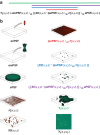DEEP-squared: deep learning powered De-scattering with Excitation Patterning
- PMID: 37704619
- PMCID: PMC10499829
- DOI: 10.1038/s41377-023-01248-6
DEEP-squared: deep learning powered De-scattering with Excitation Patterning
Abstract
Limited throughput is a key challenge in in vivo deep tissue imaging using nonlinear optical microscopy. Point scanning multiphoton microscopy, the current gold standard, is slow especially compared to the widefield imaging modalities used for optically cleared or thin specimens. We recently introduced "De-scattering with Excitation Patterning" or "DEEP" as a widefield alternative to point-scanning geometries. Using patterned multiphoton excitation, DEEP encodes spatial information inside tissue before scattering. However, to de-scatter at typical depths, hundreds of such patterned excitations were needed. In this work, we present DEEP2, a deep learning-based model that can de-scatter images from just tens of patterned excitations instead of hundreds. Consequently, we improve DEEP's throughput by almost an order of magnitude. We demonstrate our method in multiple numerical and experimental imaging studies, including in vivo cortical vasculature imaging up to 4 scattering lengths deep in live mice.
© 2023. Changchun Institute of Optics, Fine Mechanics and Physics (CIOMP), CAS.
Conflict of interest statement
The authors declare no competing interests.
Figures









Similar articles
-
De-scattering with Excitation Patterning enables rapid wide-field imaging through scattering media.Sci Adv. 2021 Jul 7;7(28):eaay5496. doi: 10.1126/sciadv.aay5496. Print 2021 Jul. Sci Adv. 2021. PMID: 34233883 Free PMC article.
-
De-scattering Deep Neural Network Enables Fast Imaging of Spines through Scattering Media by Temporal Focusing Microscopy.Res Sq [Preprint]. 2023 Jun 8:rs.3.rs-2410214. doi: 10.21203/rs.3.rs-2410214/v1. Res Sq. 2023. PMID: 37333305 Free PMC article. Preprint.
-
Focal switching of photochromic fluorescent proteins enables multiphoton microscopy with superior image contrast.Biomed Opt Express. 2012 Aug 1;3(8):1955-63. doi: 10.1364/BOE.3.001955. Epub 2012 Jul 27. Biomed Opt Express. 2012. PMID: 22876358 Free PMC article.
-
Principles of two-photon excitation fluorescence microscopy and other nonlinear imaging approaches.Adv Drug Deliv Rev. 2006 Sep 15;58(7):788-808. doi: 10.1016/j.addr.2006.07.005. Epub 2006 Aug 9. Adv Drug Deliv Rev. 2006. PMID: 17055106 Review.
-
Principles of multiphoton microscopy.Nephron Exp Nephrol. 2006;103(2):e33-40. doi: 10.1159/000090614. Epub 2006 Mar 10. Nephron Exp Nephrol. 2006. PMID: 16543762 Review.
Cited by
-
Innovative statistical approaches: the use of neural networks reduces the sample size in the splenectomy-MCAO mouse model.Croat Med J. 2024 Apr 30;65(2):122-137. doi: 10.3325/cmj.2024.65.122. Croat Med J. 2024. PMID: 38706238 Free PMC article.
-
Robust single-shot 3D fluorescence imaging in scattering media with a simulator-trained neural network.Opt Express. 2024 Feb 12;32(4):6241-6257. doi: 10.1364/OE.514072. Opt Express. 2024. PMID: 38439332 Free PMC article.
-
Scattering Correction through Fourier-Domain Intensity Coupling in Two-Photon Microscopy (2P-FOCUS).ArXiv [Preprint]. 2025 Feb 10:arXiv:2401.15192v2. ArXiv. 2025. Update in: Photonics Res. 2025 Apr;13(4):845-864. doi: 10.1364/prj.544387. PMID: 39990789 Free PMC article. Updated. Preprint.
-
Spectral Hadamard microscopy with metasurface-based patterned illumination.Nanophotonics. 2025 Feb 7;14(8):1171-1183. doi: 10.1515/nanoph-2024-0587. eCollection 2025 Apr. Nanophotonics. 2025. PMID: 40290295 Free PMC article.
-
Scattering correction through Fourier-domain intensity coupling in two-photon microscopy (2P-FOCUS).Photonics Res. 2025 Apr;13(4):845-864. doi: 10.1364/prj.544387. Epub 2025 Mar 11. Photonics Res. 2025. PMID: 40613029 Free PMC article.
References
Grants and funding
LinkOut - more resources
Full Text Sources

